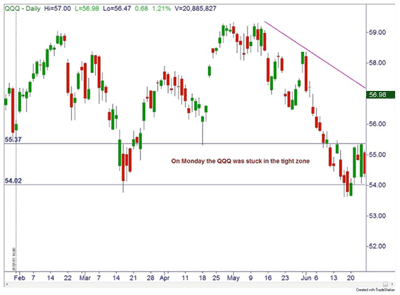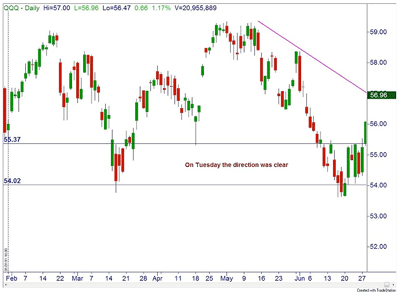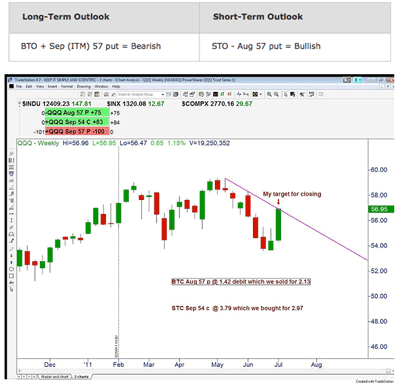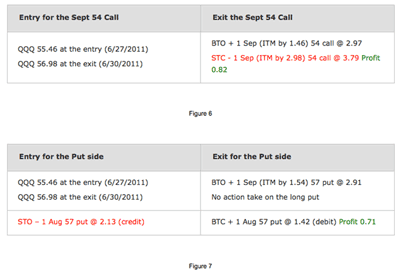This real trade example shows two particular option strategies—a strangle and a calendar spread—can be used in range-bound conditions to book consistent profits.
During an options trading class I was teaching in Southern California back in June, we were looking at the market while it was stuck in a channel and were considering placing a trade. The option trade we placed is a great example of a strangle and calendar spread, and I think it is instructional to show what we were looking at for this MoneyShow.com article.
First, here’s the chart we were watching that last part of June—the PowerShares QQQ Trust (QQQ):
After checking the current implied volatility (IV) reading at the time, we noticed the IV was in the middle of its range. Figure 1 below lists the specifics.
Reading from left to right in the graphic above, the columns list the ticker, its 52-week historical volatility high readings, its current IV reading as of the previous trading session, and its 52-week historical volatility Low.
Notice that in the IV Current column, we have the two numbers in parentheses: The current IV of 18% is 10% away from its historical volatility high reading of 28.09%; also, the IV of 18% is about 11% away from its 52-week historical volatility low. This by itself places the current IV reading in the middle of the range, which is exactly what we have stated in the conclusion column.
Based on the IV reading, we have neither the advantage of being a seller or being a buyer of options at the current time on QQQ. There is always the possibility of moving on to another underlying instead of SOH (sitting on (your) hands).
Nevertheless, for every asset and every chart, there is a strategy that can be utilized. In this case, we placed a strangle on the QQQ with the intention of turning one portion of the strangle once QQQ breaks out of its range into a horizontal spread. Next, we'll review the steps that outline the evolution of these two trades.
Article Continues on Page 2
|pagebreak|Part One: A Strangle
A strangle involves buying a call and a put in the same month, but at different strike prices. In order to explain it better, we will first look at each leg by itself.
Single-Leg Call
QQQ at $55.46 at the entry on June 27, 2011
Buy to open (BTO) + 1 Sept in-the-money (ITM by 1.46) 54 call @ 2.97
Basically, the premium of $2.97 is composed of intrinsic value ($1.46 in the money-ness) and extrinsic value ($1.51) composed of time and volatility. If we were to hold this contract all the way to expiry, then all the "fluff" (extrinsic value) would go away.
The breakeven point (BEP) would be the strike plus the premium ($54+$2.97) or $56.97, and with QQQ currently trading at $55.46, it would have to move an additional $1.51 (the exact amount of fluff) in order for us just to break even.
Single-Leg Put
QQQ at $55.46 at the entry on June 27, 2011
BTO + 1 Sept (ITM by 1.54) 57 put @ 2.91
The 57-put premium of $2.91 is also composed of intrinsic value ($1.54), which we have by subtracting the put strike price ($57) from the QQQ price at entry ($55.46). The rest of the premium, ($2.91-$1.54) which is $1.37, is the extrinsic value.
If this 57-put contract is held all the way to September expiry, then all the fluff (extrinsic value) would go away, and the BEP would be the put strike minus the premium ($57-$2.91) or $54.09, and with QQQ at $55.46 at the time of entry, it would have to drop down an additional ($55.46-$54.09) $1.37, or the exact amount of fluff, just for us to break even.
However, none of these contracts were purchased with the intention of holding it until kingdom come. The main reason why a strangle was done was that we expected a move outside of the range, which occurred the very next day.
The Next Day's Action (June 28, 2011)
QQQ opened up higher and rallied. The long 54 call went up in value, while the long 57 put lost value. QQQ had lifted from the previous close $0.50 higher to $55.76. Technically speaking, at that point, it was clear that the price action was outside of the channel and that the breakout was a valid one.
The rest of the market moved in sync with QQQ and the Dow was, at that point, trading up triple digits. It was at that point that we moved on to the second stage.
NEXT: Part Two: A Horizontal Calendar Spread
|pagebreak|Part Two: A Horizontal Calendar Spread
Our option strangle was composed of a long (ITM) call and a long ITM put. The fact that the market was up significantly meant that the put was losing money, so to remedy the bleeding from the 57 put, we could either (A) simply sell the put and take the loss, or (B) sell something against it.
Out of all the possibilities (vertical, diagonal, and horizontal), we selected the latter one. Specifically, the August 57 put was sold against our long 57 put. This transaction of selling has completely changed our position from a bearish one into a bullish one. Sold puts are always a Delta-positive, or bullish position. The figure below illustrates the dimensionality of the trade.
The market stayed bullish for the rest of the session, and by the time the market closed, we ended up having two winners (long call and the sold Aug 57 put) and one loser. However, we noticed a technical resistance, so the plan was to be long only up to the resistance, and then when QQQ hit the resistance, exit the long call for the profit and also buy back for less the sold Aug 57 put, leaving on a long Sep 57 put at the point where the market may now go down.
In conclusion, in this article, we have outlined two option strategies. The first, a strangle, was applied on an underlying that was stuck in a sideways channel at a time when we were anticipating a breakout to either side.
Once the breakout occurred, the strangle that was placed was losing money on one leg, so we turned the loser into a winner by making the losing leg into a horizontal calendar spread. This was originally pre-planned and that was the main reason why we had purchased longer-term options.
The end result was two winners out of three existing trades. The moral: Plan your trades beforehand and know exactly what you will do whichever way the positions move.
By Josip Causic, instructor, Online Trading Academy

























